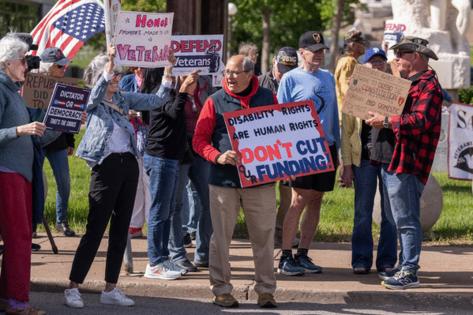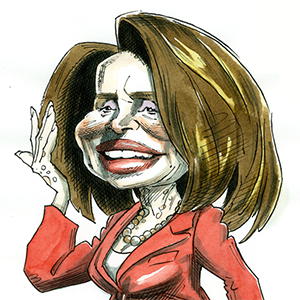Vietnam protesters in Minnesota find similarities in movement against Trump
Published in News & Features
MINNEAPOLIS — Activism is nothing new to Kathleen Laughlin, 69, who brandished a sign decrying the Trump administration’s cuts to the Department of Veteran’s Affairs at a protest in St. Paul last week.
“I’ve been to seven of these protests since March,” said the retired history professor, who first protested against the Vietnam War in the 1970s. “I’ve been a progressive Democrat my whole life.”
A budding movement across the country in response to President Donald Trump’s policies has attracted tens of thousands of Minnesotans to dozens of protests throughout the state in recent months — and more are planned.
Some who protested against the Vietnam War in the 1960s and 1970s see parallels to the current day, prompting them to take to the streets once again — 50 years after the fall of Saigon. Others never left their activism behind.
“It creates solidarity,” Laughlin said. “People are isolated; when they come together, it strengthens social movements.”
Last Thursday’s event decried the Trump administration’s reorganization of the Department of Veteran’s Affairs, which includes cutting some 80,000 jobs from a vast agency that provides health care and other services for millions of veterans.
Dave Logsdon, a retired Teamsters truck driver who lives in Minneapolis, served in the U.S. Navy for four years during the Vietnam War and then demonstrated with Veterans for Peace when he returned home. He now leads the local chapter of the antiwar organization.
“I’m still trying to bring awareness to the high moral, financial and physical costs of war,” Logsdon said at Thursday’s rally. “Every family in this country is affected by war. It’s like a rock in a pond; it has a ripple effect.”
“People put their lives on the line for their country, you should take care of them when they come home,” he said.
Carol Walker of St. Paul, who serves on the board of the Twin Cities-based group Women Against Military Madness (WAMM), added that “a lot of us were influenced by the civil rights movement, which sparked the [Vietnam] antiwar movement.”
”You don’t know what will spark people,“ she said. ”When George Floyd was murdered, that definitely was a spark where people came out in the thousands, and now with Trump and the war [in Gaza].”
Whether the public outcry over cuts to the VA, and possibly to Medicaid, Medicare and Social Security as well as to other Trump policies and executive orders will make any difference remains to be seen.
State Republicans have claimed that some resistance groups, including Indivisible, 50501 and Women’s March Minnesota, are funded by outside national interests pushing a radical agenda that have little to do with everyday Minnesotans.
“This is the darkest time in my whole life,” said Molly Wilbur-Cohen of Cedar, who is also a member of WAMM, which has held a weekly antiwar vigil on the Lake Street-Marshall Avenue bridge for the past 26 years.
“Of course it was terrible when I was young thinking ‘Oh, my gosh, it’s [Barry] Goldwater versus Lyndon Johnson for president. This is much scarier,” she said.
Scott Laderman, a history professor at the University of Minnesota-Duluth, said, like the Vietnam War era, people “are now seeing a real attack on democratic institutions, and a government that seems to be completely unresponsive to public opinion.”
“This is how folks in the late ’60s and early ’70s were talking about the U.S. government — then it was the corruption of Nixon administration, the Kent State and Jackson State killings [of students by the National Guard and police],“ he said. ”There was this sense that American society was deeply ill, with the government not responding to needs of people.”
When President Richard Nixon announced troop withdrawals from Vietnam starting in the summer of 1969, he claimed public protests and outcry had no effect on his decision to do so, said Laderman, who has written several books about the Vietnam War.
“But Nixon’s decision had everything to do with the unpopularity of the war, and the mass movement hammering him and [President Lyndon] Johnson,” he said. “By 1968, polls were showing most people wanted us to get out of Vietnam.”
One difference now is that younger people immersed in social media are accustomed to immediate gratification, Laderman said. “When things don’t happen right away, there’s real frustration,” he added.
Opposition to the Vietnam war was a “years-long movement; it took years of organizing to see some change,” he said. “Change happens slowly, and not in a steady progression.”
Keeping up the pressure in a movement can be challenging, Laderman added. “Different people are animated by different things. Not everyone shows up for the same reason.”
Indeed, Trudell Guerue, a retired U.S. Army paratrooper in Vietnam from West St. Paul, attended Thursday’s rally alongside some people who protested the very war he served in.
“We were despised,” Guerue said, when asked about the reception he received returning home after being seriously injured in Vietnam. “I almost died for them.”
But given cuts to the VA healthcare that he depends on, Guerue said he couldn’t stay home. “Look at what Trump is doing to our country.”
-----------
©2025 The Minnesota Star Tribune. Visit at startribune.com. Distributed by Tribune Content Agency, LLC.







Comments